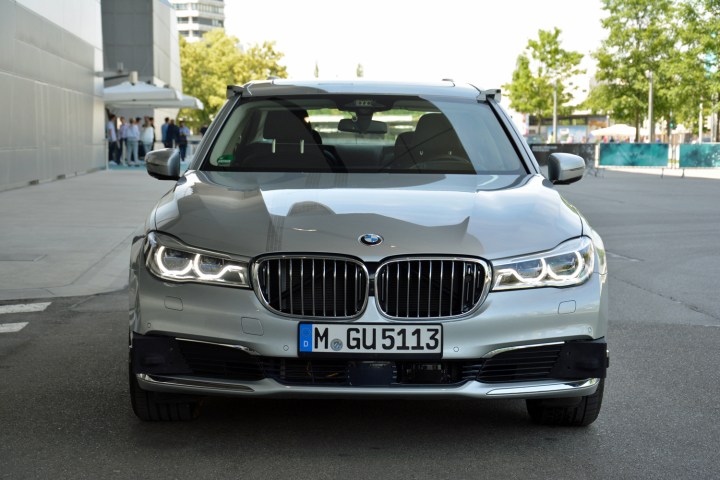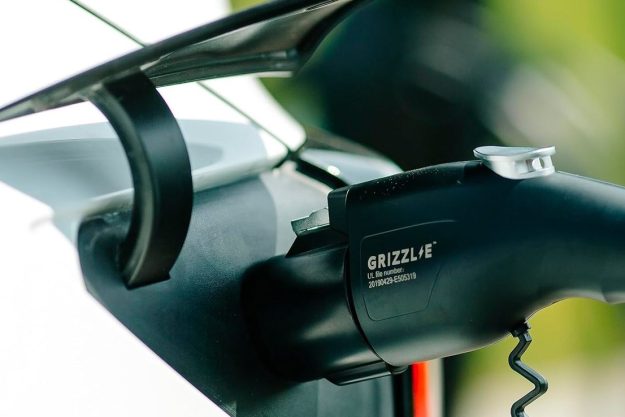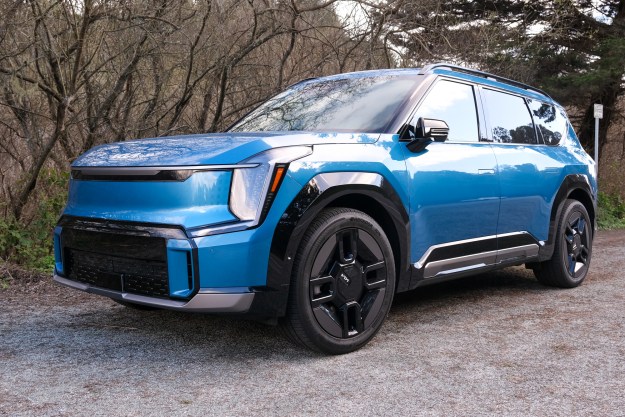
There’s nothing shockingly unusual or particularly noteworthy about seeing a stately 7 Series parked at BMW’s headquarters in Munich, Germany. Yet the silver, pre-facelift model that pulled up in front of me had at least a dozen cameras aimed at it when it arrived. No one famous was in it; no one at all was in it. It was an autonomous prototype moving under its own power, and it had been summoned to our pre-designated pick-up spot via a smartphone.
“Jump in the back, but wear your seatbelt. Riding in an autonomous car doesn’t mean you don’t need a seatbelt,” Christian Maier, one of BMW’s development engineers, told me as he opened the front-passenger door. He climbed in and buckled up, too. Another journalist hopped next to me in the back seat, but, somewhat alarmingly, the driver’s seat remained empty – unless Casper the Friendly Ghost was playing a trick on me. Could he even reach the pedals? How could he afford a 7 Series? I had so many questions.

Because there was evidently no driver to tell when we were ready, one of the passengers had to give the car the green light to move. So when everyone was seated comfortably, I tapped a blue icon on a tablet propped up on the center console, and received a confirmation message before the car slowly began to creep forward.
For this short ride, our destination was the same place as our starting point. If the car was part of the vast ride-hailing fleet BMW and partners like Lyft envision, and if I were a real-world user, I would have entered my destination in an app a lot like Uber’s before hopping in, and the car would already know where I was going as well as the best way to get me there by the time it arrived to pick me up.
Somewhat alarmingly, the driver’s seat remained empty – unless Casper the Friendly Ghost was playing a trick on me.
The ride itself was uneventful and a little bit boring, which was a really good thing. BMW would have a spectacularly serious problem on its hands if I titled this story “I rode in an autonomous prototype, and it felt just like going to Six Flags.” Fitted with level four autonomous technology, the big 7 cautiously turned when it was supposed to, drove straight when the road went straight, and stopped when someone pushed a cart full of Formula E tires in front of it. It felt much like riding in a car with a careful human driver; it drove the way I drive when I take my grandma out on a Sunday afternoon.
From the back seat, I watched the BMW roundel in the middle of the steering wheel spin on its own. The screen attached to the back of the driver’s seat provided me with the car’s view of the world around it. Monuments be damned, to this prototype Munich looks like a series of color-coded dots and lines on a black background criss-crossed with lines, like a digital sheet of graph paper.
At the end of the ride, the car dropped us off back in front of BMW’s headquarters. In real-world conditions, it would then silently waft along to the point where its next passengers would be waiting. In this scenario, its job was done so Maier pressed a button on his smartphone and instructed the prototype to park itself, which it promptly did. It backed up straight for a few yards, turned 90-degrees left, and neatly parked in a spot. I couldn’t have done it better.

One day, the sight of a car moving without anyone behind the wheel — whether it’s on a freeway or in a parking lot — might become normal. We’re not quite there, though.
Like most of the brightest minds working to make autonomous driving a reality, Maier realistically concedes full, level five autonomy (the kind that lets the driver-turned-passenger practice guitar riffs between New York and Philadelphia) isn’t ready for mass-production yet. When will it be? It’s difficult to say, and it doesn’t depend fully on how quickly technology advances. Legislation must be put in place before motorists can purchase a fully autonomous car for their personal use, and I’d bet the cost of the most high-tech lidar unit on the market that self-driving technology will appear in the freight and ride-sharing sectors well before it seeps into standard passenger cars.
BMW invests between six and seven percent of its annual revenues into research and development.
In the meantime, BMW invests between six and seven percent of its annual revenues into research and development, and it’s gradually adding features to its cars that make driving more convenient in a variety of situations. For example, it expanded its suite of level two electronic driving aids with an evolution of adaptive cruise control that reads traffic signals, and brings the car to a stop when it recognizes the light is red.
I experienced this from the back seat of a 2020 3 Series, and I was surprised by how smoothly the system operated. With adaptive cruise control turned on and traffic light recognition active, the car knew to slow down if it saw an orange light, and it also recognized green lights – this feature would be a little bit useless if it didn’t. The 3 began moving as soon as the car in front of it pulled away, but when it was first in line my driver needed to push a button on the steering wheel to confirm it was safe to move.

He explained BMW added the confirmation function because, ultimately, the driver remains responsible for making sure it’s safe to cross an intersection. Technology takes care of the rest; the only thing it doesn’t do is hit the horn if the person in front is too busy texting to notice the light is green. If you’re wondering: that’s not a feature BMW plans to add to its cars.
Traffic light recognition technology is easier to implement than full autonomy, so it’s much closer to production. Engineers will continue to fine-tune it in the coming months, and a BMW representative told me it’s about a year from being available in series-produced cars sold in the United States. Remote-controlled parking is on its way to production, too, and it’s a technology Maier told me he finds highly promising. These features are stepping stones in BMW’s quest to develop the ultimate self-driving machine, without losing its focus on delivering dynamism when the occasion calls for it.




